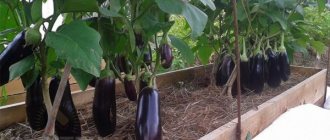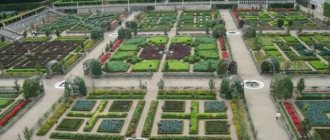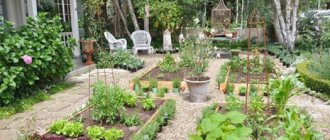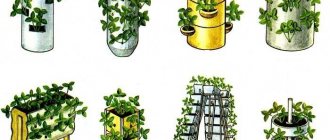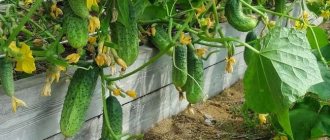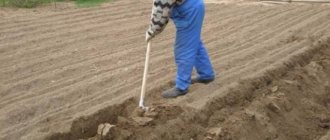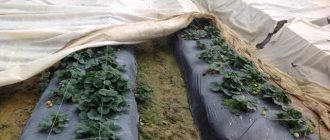Mitlider beds - description and characteristics of the technology
This technology is based on balanced nutrition coupled with the organization of optimal and convenient conditions for various plants. They are planted in narrow, uniform beds with wider passages between them. Standard sizes for most popular garden crops, including potatoes, carrots, tomatoes and eggplants, are 10 cm wide, 45 cm high and 105 cm deep.
In greenhouse growing conditions, it is possible to narrow these indicators to 30 cm in width and 90 cm in aisles. Vegetables are planted in pairs, in a row, maintaining distances from the edge of the bed (10–15 cm) and between rows (15–20 cm). Other features depend on the behavior of specific crops, their root system, the degree of spreading of the bushes, the height of the stem, etc. Large crops, such as tomatoes, zucchini, squash or pumpkin, are planted in one row, planting them along the edge of the bed so that they had space for proper growth and development.
Experts consider the main feature and advantage of the Mittleider method to be uniform distribution of light and improved absorption of moisture after watering. In addition, such narrow mini-vegetable gardens accumulate more nutrients in the soil, which has a beneficial effect on all plants without exception.
Other features include:
- Pure chemical composition of the fruit. Due to a special irrigation system, precipitation does not accumulate on the beds, but immediately flows into organized wide passages, and some harmful substances, including strontium, lead or aluminum, are not deposited in the fruits.
- Easy to care for vegetables. Thanks to this system, all plant care comes down to timely watering, fertilizing and periodic loosening of the soil. The compact shape of the beds allows fertilizers to be better absorbed and distributed evenly throughout the mini-plot, which promotes rapid development and improves the taste of ripe fruits.
But this technology is not suitable for all types of plots and garden crops, so Professor Mittleider also identified some limitations that do not allow obtaining the desired effect.
Care recommendations and common mistakes
Mittleider identified the conditions under which the application of his method does not bring results. It is not recommended to build a vegetable garden with narrow edges:
- in low-lying areas with high groundwater;
- the beds should be placed horizontally, so they should not be erected on relief areas; in this case, fertilizers will flow down the slope and will not benefit the plants;
- poorly lit areas reduce yields and contribute to the accumulation of nitrates;
- windy areas contribute to drying out of the soil;
- infrequent watering promotes the crystallization of minerals that linger on the soil surface;
- the distance from the road must be at least 100 m.
The most common mistakes when organizing a vegetable garden using the Mitlider method lead to a decrease in yield:
- It is not recommended to use pure manure before planting;
- During growth, any crop needs abundant nutrition, so you should not fertilize less than once every 10 days;
- It is necessary to organize daily abundant watering so that minerals do not stagnate on the soil surface.
In the fall, after harvesting, Dr. Mittleider advises preparing the garden and adding the following organic substances to the garden bed:
- A layer of straw 10-15 cm thick is laid on the ground.
- A layer of manure of 15-20 cm is poured on top.
- Then a peat layer 15-20 cm thick.
- The sandwich is covered with a mixture of phosphate rock and lime in a 1:1 ratio.
- A 15-20 cm layer of manure is laid again.
- They are finally covered with earth, 10-15 cm thick.
In this state, the cake is left to rot until spring. Then the bed is dug up, fertilizers are added and loosened. This method significantly increases the formation of humus in the soil and helps increase productivity.
Restrictions on using the method in the garden
Constructing narrow beds and growing vegetables in this alternative way is not practical in lowlands or in areas with groundwater close to the surface. Due to precipitation and spring floods, large amounts of liquid often stagnate on them, which negatively affects narrow row spacing and leads to rotting of plant roots.
The location of the beds must be strictly horizontal, so areas that are located on a slope and other terrain are not suitable for using this method, since in one part there will be a greater accumulation of water and nutrients, while the other will suffer from a lack of them, which will lead to partial or serious loss of yield.
The method is not used in heavily shaded gardens with uneven light distribution, as well as on peat and clay soils. The best option is light loamy or sandy loam soil with a nearby water source. It is not recommended to organize such beds near highways or highways; the plants will absorb harmful substances from polluted air with redoubled force. The minimum distance from such objects is 100–150 meters.
Advantages
Planting vegetables according to Mittleider has received support in more than 30 countries around the world. Among the advantages of this method are:
- Increased productivity . For gardeners who are accustomed to planting hectares of land with vegetables, the method of growing crops in narrow beds does not seem promising. However, having tried it once, they come back to it again. The thing is that plants planted in narrow areas absorb solar energy, water and nutrients as efficiently as possible. In addition, when entering into the struggle for survival, they are forced to compete with each other, which leads to the ripening of stronger fruits.
- The need to use less nitrates. According to Mitlider technology, in the process of growing vegetable crops, fertilizing with magnesium and molybdenum is mandatory. It is these substances that are responsible for converting nitrates into amino acids and proteins necessary for plant growth and fruit formation. Refusal of organic matter is the principled approach of the author of this method.
Related article:
How to make beds using the Kurdyumov method
- Limiting the absorption of harmful substances. The technology of planting in a narrow bed involves limiting space, which leads to the formation of a compact root system in plants. Wide passages are a barrier to moisture, which is oversaturated with aluminum, strontium and other harmful substances after rains.
- Can be used in any climate. Despite the fact that Mittlider tested his planting technology in countries with warm climates, this method is successfully used in Russia, but with partial adjustments for the peculiarities of gardening in regions with cold climates.
Options for building beds according to Mitlider
Implementing American technology in your garden plot is possible in two ways. Either they install special box beds with sides, or they organize planting directly on the soil. In the first option, compact boxes are constructed from wood, polycarbonate or other suitable material, which are filled with fertile substrate (the lower layer is natural soil, the upper layer is a nutritious soil mixture) and installed in open areas or in greenhouses.
The advantages of using this method of planting include:
- No need to level the soil. “Wooden” beds can be placed on sandy, clayey and heavily eroded soils; the main thing is to properly prepare the garden substrate and choose a place to install the beds.
- Improving the winter hardiness of plants planted in small areas. The presence of walls additionally insulates garden crops during winter cold and autumn frosts. They also serve as a barrier against the penetration of certain weeds and garden pests.
Open beds are placed exclusively on flat surfaces, in spacious, well-lit and ventilated areas with fertile soil. In this case, the sides are made from soil, and the vegetables should grow at the same level.
The principle of care according to the Mittleider method does not depend on the chosen option. The first method is preferable for greenhouses and small vegetable gardens; in fields or large areas, the “earthen” version is used.
Greenhouses using the Mittlider method
The design provides special air circulation, which prevents condensation from collecting. The frame itself is made very durable. The use of screws instead of nails makes the structure collapsible.
Photo of a greenhouse and narrow beds using the Mitlider method
A stable microclimate is achieved by a large area of the structure. Additional mechanisms and devices (dispensers and ventilation hatches) are not used.
To save space, the beds themselves are somewhat narrowed - up to 0.3 m. The row spacing is, accordingly, up to 0.9 m. The length is usually half that of those placed in the fresh air.
As with open beds, greenhouses are as convenient as possible for the movement of people serving them, as well as for equipment and harvesting.
Arrangement of beds with your own hands
Before using the method of growing in beds from Professor Mittleider, 4 main factors are taken into account:
- selection of a suitable and optimal site;
- determining a specific method for planting vegetables;
- development of plant placement schemes;
- proper soil preparation.
The first stage has already been mentioned above; the best place for planting various vegetable crops is a well-lit and ventilated area with a flat surface. The most important thing is to minimize the risk of flooding or stagnation of water.
The choice of arrangement method also depends on the conditions of a particular area. If there is no need to level the area, and the soil meets all the fertility requirements, then make natural ridges 40–45 centimeters wide and an optimal length of 7–9 meters.
It is easier to achieve a horizontal surface using boxes; they are also most preferable when constructing beds on depleted soil, since it is easy to add the required amount of nutrient substrate to them. The direction of the beds plays an important role; the recommendations state that it is best to form them from east to west, but in more severe climatic conditions it is permissible to organize plantings from north to south.
When choosing a direction, take into account the characteristics of the plants that are planned to be planted. Tall species are sown from north to south, the distance between large-fruited crops (cabbage, eggplant, etc.) should be 30-35 cm. Between small root crops (onions, garlic, beets, carrots) - 5-10 cm, staggered.
When constructing a wooden or plastic box, the last layer of soil should be a pre-prepared nutrient mixture, the components of which depend on the characteristics of the plants being grown, but universal options are prepared from sand with peat and turf soil in equal proportions, and pine sawdust, perlite or fine-grained sand are also added to them . When using a completely artificial substrate, it is necessary to qualitatively and correctly prepare complex starting fertilizers.
The essence of the system
Dr. Mittlider has been studying the peculiarities of horticulture and gardening in different countries of the world for more than fifty years and has the title of international agricultural consultant. Having been involved in agriculture all his life, one day he was faced with the problem of deteriorating taste of vegetables and the constant need to use large amounts of fertilizers. Experiments began that resulted in the emergence of a new method of vegetable growing.
Related article:
Name and photo of weeds
Jacob Mittlider
Vegetable garden according to Mittleider - plants planted on perfectly flat narrow plots of land. The method is based on simple geometry: the balance of the width of the ridges and the distance between them makes it possible to provide the plants with balanced nutrition, which ultimately enhances their growth and helps increase productivity.
Also interesting to read: How to make raised beds on your property
Construction of boxes using do-it-yourself technology
To make boxes of suitable size yourself, you will need the following materials:
- short boards (45 cm) for cross sides;
- long options for organizing the main walls of the box;
- bars for supports with a section of 5x5 cm;
- agrofibre and marking rope;
- level, tape measure, fasteners and equipment (screws, nails, screwdriver);
- antiseptic agent for wood protection.
The first step is to mark the area using a rope that is pulled between the wedges. The latter are installed in the corners, having previously measured the required distances with a tape measure (45 cm wide and 1 m per passage) and aligned them to the same height.
Now all the wooden boards and support beams are joined and secured to the sides with self-tapping screws or other fasteners. Then they are leveled to the building level; there should be no transverse or longitudinal slopes. At the final stage, a layer of fertile soil is poured into the boxes, and a mixed nutrient substrate is placed on top, or the container is completely filled with an “artificial” soil mixture if the soil on the site does not meet the requirements.
The resulting beds are fertilized with mineral pre-sowing complexes, but organic substances in the form of compost, mullein or bird droppings are not used. Layer options may vary, the main thing is to combine fertile soil, geotextile and useful substrate.
Growing in boxes using the Mittleider method
The edges for the beds are made of slate, boards or plastic. Growing plants in boxes refers to a two-layer method, in which the soil on the site is the first tier, and the organic soil mixture is the second.
Rules for arranging mitlider boxes:
- The beds are arranged on a flat area.
- Box width 45-120 cm, height 20 cm, arbitrary length 3-9 m. Wide beds are acceptable under drip irrigation conditions. The row spacing is 90 cm.
- The soil mixture is prepared from soil, sawdust of different fractions, sand and perlite.
- There is no need to replace the soil annually; it is necessary to fill it up to the level of the bed, since the soil settles over the season.
- To prolong fertility, sphagnum moss, nut shells, and seed husks are added to the substrate. This increases the formation of humus and soil fertility.
Attention! In boxes, the growing season increases; in the spring the soil warms up faster, and in the fall it cools more slowly. Arranging a greenhouse on the beds will speed up and extend the harvest period.
The boxes are installed in areas that are flooded with water. This way the plants will not be harmed and the harvest will be saved. Below is a vegetable garden according to Mittleider in the photo:
The soil in the garden bed is dug up, carefully breaking up the lumps, covered with fertilizers and filled with water until the fertilizers are completely dissolved. The boxes are installed on depleted clay and sandy soils, the second layer of organic substrate with fertilizers will increase the yield. The correct ratio of mineral and organic fertilizers leads to a good harvest.
Stages of work on constructing a vegetable garden:
- Construct boxes from 2*20 cm boards according to the size of the bed.
- Level and clear the area of plants and debris. Using stakes and twine, the beds and row spacing are marked out. The width of the ridge is 45 cm, the passage is 100 cm.
- The boxes are installed and the seedlings are planted.
- Connect drip irrigation.
At the installation stage of the boxes, the level is carefully measured, since distortion of the structure is unacceptable
Preparing a narrow version of the bed according to Mitlider
To build an ordinary garden bed with your own hands, you will need all the same materials except boards, plus garden tools - a pitchfork, a shovel and a rake. Work begins with cleaning and preparing the area. All weeds are removed, the root remains of previous garden crops are uprooted with a pitchfork, and the entire area is carefully dug up.
Then the soil is leveled with a rake, making its surface as smooth as possible. Now, using a tape measure, take measurements and drive in pegs in the corners. Saving space by narrowing aisles is not recommended. The established 95–105 cm are observed to ensure that the plants receive enough sunlight and do not shade each other as they grow.
To control the uniform height, a tight rope is pulled, then bulk sides are made and the inner area is leveled with a rake.
Visually check the level; there should be no differences in heights, otherwise water will accumulate in them and the effectiveness of the method will significantly decrease.
In addition, they also make a frame for winter shelter; for this purpose, plastic arches are installed on both sides, onto which it is then easy to stretch and secure suitable material. If all points of the instructions are followed, begin preparing the seeds and the corresponding starting fertilizers.
Tomatoes in narrow beds
Tomatoes are one of the finicky vegetables. They get sick easily and do not grow well in humid climates. But the use of Mitlayder planting technology allows you to get a good harvest.
According to Dr. Mittleider's recommendations, planting tomatoes in narrow beds should begin in May. In this case, immediately cover the seedlings with film. It should be remembered that it is recommended to plant tomatoes of different varieties at a considerable distance from each other.
Leeks: description, features of growing from seeds
Productivity will directly depend on how much light the plant receives. If there is little light, then there will be less fruit.
To ensure sufficient lighting, only one stem is left on the tomato bush. All stepchildren are pruned at least once a week during the growing season. After the fruits are formed, all leaves that can block access to light are cut off. In early August, you need to remove the apical shoot.
As for feeding and care, here you need to follow the standard midlife scheme. To create the ideal fertilizer mixture, it is best to use a special calculator.
Features of irrigation when using the method
Vegetable growing in narrow beds and small areas proceeds normally only with constant and comprehensive watering of the plants planted in them. The features of the Mitlider technology lie in compliance with the conditions discussed below.
Root hydration. Watering is carried out only in this way, since additional irrigation of the green part of the plant and sprinkling of the soil contribute to the formation of a favorable environment for various diseases and pests.
Water should only fall on narrow beds, while the passages should be left dry; for this purpose, side wooden or earthen sides are constructed.
Daily summer watering. In the warm season, the soil is moistened frequently and abundantly. If it is not possible to do this constantly, then install a high-quality automatic drip irrigation system. The liquid should be clean, warm, with a minimum content of calcium salts and magnesium.
Water the beds in the morning, afternoon or evening, but with the onset of August, evening approaches are stopped so as not to provoke the appearance of powdery mildew, especially in some vegetable crops.
Narrow ridges in Russian
In Russia, Doctor of Biological Sciences Tatyana Yurievna Ugarova was seriously involved in vegetable growing according to Mitlaider. She accompanied her American colleague on his trips while living in Russia and became acquainted with his work. Ugarova was interested not only in yield, but also in product quality. She applied Mittleider's technology of narrow beds in Russian: she raised questions about the content of useful substances and nitrates in vegetables.
Chemistry and nature
Most people involved in agriculture know little about the chemistry and biology of plants and do not understand the differences between organic and inorganic compounds. Therefore, in Russia, the Mittleider method is received with hostility by many ignorant people. Scientists are called charlatans. And the very word “chemistry” in growing vegetables scares them.
Thoughtlessly and haphazardly using fertilizers, people caused great harm to the soil and their health and rushed to the extreme - they began to use manure and compost for cultivation. But with these additives you can easily get nitrate vegetables.
Research results by T. Ugarova
Ugarova found that vegetables grown in narrow beds are of high quality - according to chemical analyses, appearance and taste. In his publication “Family vegetable growing on narrow beds. Experience of using the Mitlider method in Russia" Tatyana Yuryevna Ugarova claims that with this technology:
- Soils are not poisoned because pesticides are not used;
- plants receive all the necessary nutrients;
- active photosynthesis in plants contributes to maximum self-purification.
In the modern world, it is difficult to find unpolluted lands, clean air and water. The lack of fertilizers in your garden does not mean that the harvest will be “clean”. Only calculation, a scientific approach and strict adherence to the instructions of chemists and vegetable growers will help to obtain not only an abundant, but also a high-quality product from the garden.
Recommendations for applying fertilizers and fertilizing
The entire process of feeding garden crops in Mittleider’s beds comes down to a combination of two nutrient mixtures. They are created taking into account the balance of nutrients and trace elements necessary for plants, including phosphorus, potassium, nitrogen and iron. These arrangements have been time-tested in various climatic conditions and are used in all countries where this planting method is used.
The first option is designed to level out acidity and improve the calcium composition of the soil. It includes dolomite flour, boric acid or sodium borate, chalk or slaked lime, which are added during the pre-sowing preparation period. Before using these fertilizers, the acidity factor of the soil is determined as accurately as possible, for which a special device or folk remedies are used.
During the active growing season of plants, mineral complexes and mixtures are used, for which superphosphate (100–110 g), urea (200 g), nitrophoska (420 g), potassium magnesia (270 g), boric or molybdic acid, 2 and 3 g, respectively, are combined. .
Plant feeding is carried out in three mandatory stages. Before planting, add 2 parts of the first mixture and 1 part of the second mixture to the soil. The soil is watered abundantly at the roots and the beds are dug up. Next, surface fertilization is carried out once a week while adding liquid. 60–70 grams of a mixture of the mineral complex is enough for one standard bed.
If necessary, additional nutrients are added to a particular crop, especially if its appearance indicates a deficiency of one of the important elements. This can be copper or zinc sulfate, manganese sulfate, etc. As practice shows, for normal yields of popular vegetables (potatoes, beets, onions, tomatoes), it is enough to follow the above rules and composition, as well as timely and proper watering.
The Mittleider method is a whole system of principles for working with soil, lighting, watering and fertilizing. When using this alternative and largely non-standard technology, every little detail should be calculated. It’s better to start with one small bed in order to evaluate the effectiveness of the method and the feasibility of its use in your garden plot or vegetable garden.
Fertilizer mixtures
When growing vegetables according to Mitlider, it is recommended to use two types of mixtures for fertilizer:
— Mixture 1. Lime fertilizer (boron and calcium), applied before planting. Consumption per linear meter of Mittleider bed: 100 g (light soil) or 200 g (heavy soil). Light soils include sandy soils, and heavy soils include clay and peaty soils.
— Mixture 2. Mineral mixture for regular feeding once a week (potassium, phosphorus, nitrogen, magnesium, molybdenum, boron). Consumes 60 grams. at 1 m.
Organic fertilizers can be used to nourish and improve soil health. It is important to remember that organic matter must warm up well, rot, and turn into compost; then, under the influence of heat, the weed seeds will become unviable. In addition to weeds, unrotted fertilizers can cause plant diseases and increase the number of pests. The microflora living in compost suppresses pathogens of such diseases and improves soil properties.
The Mittleider method in the Russian version most often involves the use of manure. Well-rotted compost or manure humus is applied in the spring for digging and in preparation for planting. Applying 0.5-1 buckets of fertilizer per 1 m of bed can be combined with filling the soil with mixtures 1 and 2. When adding more buckets (up to three), it is recommended to avoid filling the soil with the second mixture.
Practical application of the system
If you decide to use this method, then you need to calculate everything correctly.
Site planning. We mark the land plot in advance. After marking, we determine the required number of seedlings, the necessary materials for forming ridges and how much fertilizer will be needed. In order for the plants to receive more light, the beds are placed from east to west, they are made into soil or on side. You should make your choice in advance. The sides complicate the organization of beds; they require additional material.
Watering. The traditional method of watering (sprinkling) will have to be eliminated. With this method, weeds grow and mold appears. It is better to use the root method or hand irrigation. Drip irrigation is the most suitable option, which saves water and labor costs.
Fertilizers. Fertilize the garden according to a schedule with special mixtures (recipes below). You should calculate in advance the required number of components for fertilizers so that there are no unexpected costs for their purchase.
